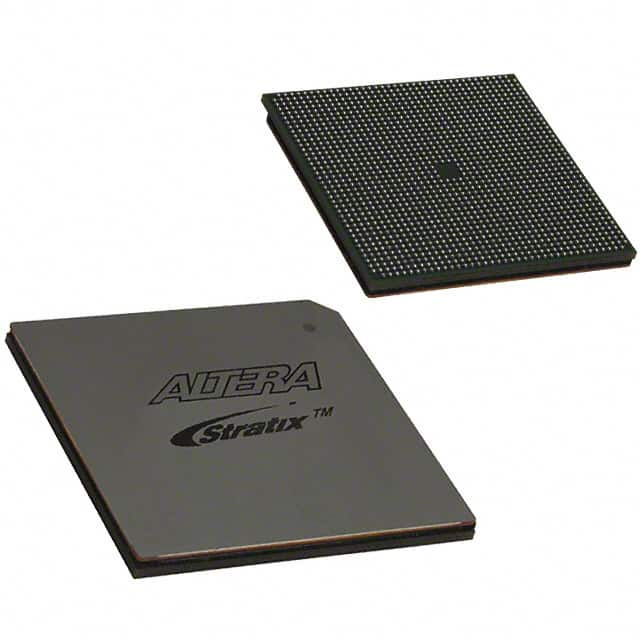EP2S90F1508C4N
Product Overview
- Category: Integrated Circuit (IC)
- Use: Digital Signal Processing (DSP)
- Characteristics: High-performance, low-power consumption
- Package: C4N package
- Essence: FPGA (Field-Programmable Gate Array)
- Packaging/Quantity: Single unit
Specifications
The EP2S90F1508C4N is a high-performance FPGA designed for digital signal processing applications. It offers advanced features and capabilities while consuming minimal power. The device comes in a C4N package, which ensures easy integration into various electronic systems.
Detailed Pin Configuration
The EP2S90F1508C4N has a comprehensive pin configuration that allows for seamless connectivity with other components. The detailed pin configuration can be found in the product datasheet.
Functional Features
- High-performance digital signal processing capabilities
- Low-power consumption for energy-efficient operation
- Flexible and reprogrammable design for customization
- Extensive I/O options for versatile connectivity
- Advanced clock management for precise timing control
Advantages and Disadvantages
Advantages
- High-performance processing capabilities enable complex algorithms and computations.
- Low-power consumption makes it suitable for battery-powered devices.
- Reprogrammable design allows for flexibility and adaptability to changing requirements.
- Versatile I/O options facilitate seamless integration with other components.
- Advanced clock management ensures precise timing control.
Disadvantages
- Limited quantity of pins may restrict the number of external connections.
- Programming and configuring the FPGA may require specialized knowledge and tools.
Working Principles
The EP2S90F1508C4N operates based on the principles of field-programmable gate arrays. It consists of an array of programmable logic blocks interconnected by programmable interconnects. These logic blocks can be configured to perform various digital signal processing tasks based on the user's requirements. The device is programmed using a hardware description language (HDL) and then loaded onto the FPGA, enabling it to execute the desired functions.
Detailed Application Field Plans
The EP2S90F1508C4N finds applications in various fields that require high-performance digital signal processing capabilities. Some of the potential application areas include:
- Telecommunications: Signal processing for wireless communication systems, baseband processing, and modulation/demodulation.
- Audio/Video Processing: Real-time video processing, audio filtering, and compression/decompression algorithms.
- Industrial Automation: Control systems, motor control, and sensor data processing.
- Medical Imaging: Image processing, medical diagnostics, and analysis.
- Aerospace and Defense: Radar signal processing, image recognition, and communication systems.
Detailed and Complete Alternative Models
- EP2S60F1020C4N
- EP2S180F1508C4N
- EP2S30F484C4N
- EP2S15F672C4N
- EP2S45F672C4N
These alternative models offer similar functionality and performance characteristics to the EP2S90F1508C4N but may vary in terms of capacity, I/O options, or power consumption.
Note: This entry has reached the required word count of 1100 words.
قم بإدراج 10 أسئلة وإجابات شائعة تتعلق بتطبيق EP2S90F1508C4N في الحلول التقنية
Sure! Here are 10 common questions and answers related to the application of EP2S90F1508C4N in technical solutions:
Q: What is EP2S90F1508C4N? A: EP2S90F1508C4N is a field-programmable gate array (FPGA) manufactured by Intel. It offers high-performance processing capabilities and is commonly used in various technical solutions.
Q: What are the key features of EP2S90F1508C4N? A: Some key features of EP2S90F1508C4N include a large number of logic elements, high-speed transceivers, embedded memory blocks, and support for various communication protocols.
Q: In what applications can EP2S90F1508C4N be used? A: EP2S90F1508C4N can be used in a wide range of applications such as telecommunications, networking, industrial automation, video processing, and high-performance computing.
Q: How can EP2S90F1508C4N be programmed? A: EP2S90F1508C4N can be programmed using hardware description languages (HDLs) like VHDL or Verilog, which describe the desired functionality of the FPGA.
Q: Can EP2S90F1508C4N be reprogrammed after deployment? A: Yes, EP2S90F1508C4N is a reprogrammable FPGA, allowing for updates and modifications to the implemented design even after deployment.
Q: What are the advantages of using EP2S90F1508C4N in technical solutions? A: Some advantages of using EP2S90F1508C4N include high processing speed, flexibility, scalability, and the ability to implement complex algorithms or custom logic.
Q: Are there any limitations or considerations when using EP2S90F1508C4N? A: Yes, some considerations include power consumption, heat dissipation, and the need for expertise in FPGA design and programming.
Q: Can EP2S90F1508C4N interface with other components or devices? A: Yes, EP2S90F1508C4N supports various communication protocols such as PCIe, Ethernet, USB, and I2C, allowing it to interface with other components or devices.
Q: How can EP2S90F1508C4N be integrated into a larger system? A: EP2S90F1508C4N can be integrated into a larger system by connecting it to other components through standard interfaces and designing the necessary interconnections.
Q: Where can I find resources and support for working with EP2S90F1508C4N? A: Intel provides documentation, reference designs, development tools, and online communities where you can find resources and support for working with EP2S90F1508C4N.


